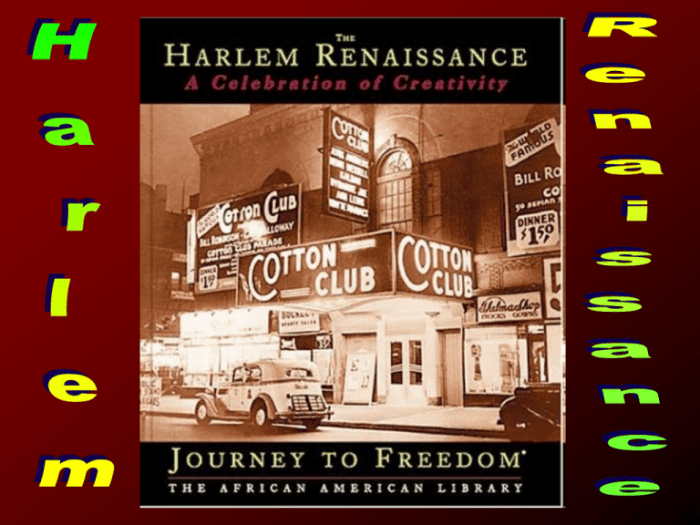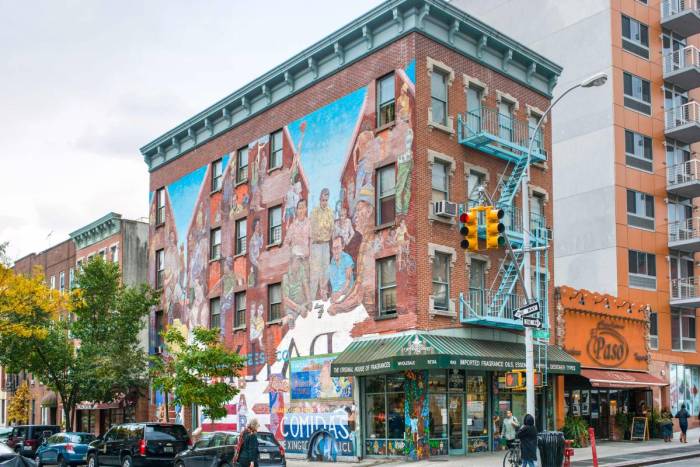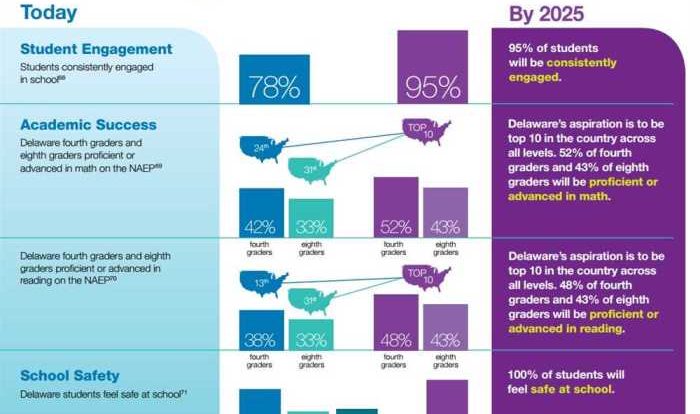The Harlem Renaissance Mastery Test is a comprehensive assessment designed to evaluate an individual’s knowledge and understanding of the Harlem Renaissance, a pivotal cultural movement that profoundly impacted American society and culture in the early 20th century. This test provides a valuable tool for educators, students, and researchers to assess their mastery of this important historical period.
The test encompasses a wide range of topics related to the Harlem Renaissance, including its key figures, literary works, artistic achievements, and social and political contexts. By taking this test, individuals can demonstrate their understanding of the movement’s origins, development, and legacy, as well as its broader implications for American history and culture.
Overview of the Harlem Renaissance Mastery Test
The Harlem Renaissance Mastery Test is an assessment tool designed to evaluate an individual’s knowledge and understanding of the Harlem Renaissance, a significant cultural and artistic movement that flourished in the 1920s and 1930s in the Harlem neighborhood of New York City.
The test aims to measure the test-taker’s familiarity with the key figures, themes, and historical context of the Harlem Renaissance. It also assesses their ability to analyze and interpret literary works, artistic creations, and historical events associated with this period.
Purpose of the Test
The Harlem Renaissance Mastery Test serves several purposes:
- Assessment of Knowledge:The test provides an objective measure of an individual’s knowledge of the Harlem Renaissance.
- Educational Evaluation:It can be used by educators to assess students’ understanding of the subject matter.
- Research and Analysis:The test results can contribute to research and analysis on the Harlem Renaissance, helping scholars gain insights into its impact and legacy.
Scope of the Test, The harlem renaissance mastery test
The Harlem Renaissance Mastery Test covers a broad range of topics related to the Harlem Renaissance, including:
- Historical Context:The social, economic, and political factors that shaped the Harlem Renaissance.
- Key Figures:The writers, artists, musicians, and intellectuals who were central to the movement.
- Literary Works:The major literary works produced during the Harlem Renaissance, including novels, poetry, and plays.
- Artistic Creations:The visual art, music, and dance that emerged from the Harlem Renaissance.
- Cultural Impact:The influence of the Harlem Renaissance on American culture and society.
Content and Structure of the Test
The Harlem Renaissance Mastery Test assesses candidates’ knowledge and understanding of the historical and cultural significance of the Harlem Renaissance. The test is divided into three sections:
- Historical Context and Background: This section covers the historical and social factors that led to the emergence of the Harlem Renaissance, as well as the key figures and institutions involved.
- Literary and Artistic Contributions: This section focuses on the literary and artistic achievements of the Harlem Renaissance, including the works of notable authors, poets, musicians, and visual artists.
- Cultural Impact and Legacy: This section examines the cultural impact of the Harlem Renaissance, its influence on American society, and its lasting legacy.
The test includes a variety of question types, including:
- Multiple-choice questions
- Short answer questions
- Essay questions
Preparation Strategies for the Test

To excel on the Harlem Renaissance Mastery Test, effective preparation is crucial. This involves employing efficient study methods, utilizing appropriate resources, and honing test-taking skills.
First and foremost, a structured study plan is essential. Create a schedule that allocates ample time for reviewing the relevant material. Prioritize topics based on their significance and difficulty level, and allocate more time to areas that require additional attention.
Effective Study Methods
- Active Recall:Regularly test yourself on the material covered. Use flashcards, practice questions, or engage in discussions to actively recall information and strengthen your understanding.
- Spaced Repetition:Review the material at increasing intervals (e.g., 10 minutes, 1 hour, 1 day, 1 week). This helps reinforce the information in your long-term memory.
- Elaboration:Connect new information to existing knowledge by explaining concepts in your own words, creating diagrams, or drawing analogies.
- Retrieval Practice:Regularly retrieve information from memory without looking at your notes. This strengthens neural pathways and improves your ability to recall information during the test.
Resources for Study
- Textbooks and Reference Books:Utilize reputable textbooks and reference books that provide comprehensive coverage of the Harlem Renaissance.
- Online Resources:Explore credible websites, databases, and online archives that offer additional information and primary source documents.
- Documentaries and Films:Immerse yourself in the subject matter through documentaries and films that provide visual and auditory reinforcement.
Improving Test-Taking Skills
- Time Management:Familiarize yourself with the test format and allocate your time wisely during the actual test.
- Question Analysis:Carefully read each question and identify the key terms and concepts. Determine what type of response is required (e.g., short answer, essay).
- Answer Organization:Structure your answers clearly and logically, providing evidence and examples to support your claims.
- Proofreading:Before submitting your test, take a few minutes to proofread your answers for any errors in grammar, spelling, or punctuation.
Applications of the Test Results

The Harlem Renaissance Mastery Test results provide valuable insights for educational purposes. They can help identify areas where students need additional support and pinpoint specific areas of strength.
For Students
*
-*Personalized Learning
The test results can guide students towards tailored learning experiences that address their individual strengths and weaknesses.
-
-*Educational Goal Setting
Students can use their results to set realistic educational goals and track their progress over time.
-*Self-Reflection and Motivation
The test provides students with a benchmark against which they can measure their progress, fostering self-reflection and motivating them to strive for improvement.
For Educators
*
-*Curriculum Development
The test results can inform curriculum development by identifying areas where students may require additional support or enrichment.
-
-*Instructional Planning
Educators can use the results to plan lessons that effectively address the specific needs of their students.
-*Student Assessment
The test provides a standardized measure of student learning, allowing educators to assess student progress and identify areas for improvement.
Sample Test Questions and Answers
The Harlem Renaissance Mastery Test assesses individuals’ knowledge and understanding of the historical, cultural, and literary significance of the Harlem Renaissance. To provide a comprehensive evaluation, the test includes a range of question types designed to gauge proficiency in various aspects of the subject matter.
The following table presents sample test questions along with their correct answers:
| Question | Answer |
|---|---|
| Who is considered the “Father of the Harlem Renaissance”? | W.E.B. Du Bois |
| Name a prominent literary figure associated with the Harlem Renaissance. | Langston Hughes, Zora Neale Hurston |
| What was a key theme explored in Harlem Renaissance literature? | African American identity, racial equality |
| Which artistic movement influenced the visual arts during the Harlem Renaissance? | Cubism, Art Deco |
| How did the Harlem Renaissance contribute to American culture? | Promoted African American art, literature, and music, challenged racial stereotypes |
Historical and Cultural Context of the Harlem Renaissance
The Harlem Renaissance, a period of extraordinary cultural and artistic achievement, emerged within the African American community of Harlem, New York, during the 1920s and 1930s. It was a time of intense creativity and innovation, fueled by a surge of racial pride and a desire for self-expression.The
Harlem Renaissance was shaped by a number of key figures, including writers such as Langston Hughes, Zora Neale Hurston, and Claude McKay; musicians like Duke Ellington, Louis Armstrong, and Bessie Smith; and visual artists such as Jacob Lawrence and Archibald Motley Jr.
These individuals, along with countless others, contributed to the creation of a rich and vibrant cultural landscape that challenged prevailing stereotypes and celebrated the diversity of African American life.The impact of the Harlem Renaissance on American culture and society was profound.
It helped to break down racial barriers and paved the way for greater recognition of African American artists and intellectuals. The movement also inspired a new sense of cultural pride among African Americans and fostered a greater appreciation for the contributions of African American culture to American society as a whole.
Key Figures of the Harlem Renaissance
- Langston Hughes: A poet, novelist, and playwright, Hughes was one of the leading figures of the Harlem Renaissance. His work explored themes of race, identity, and the African American experience.
- Zora Neale Hurston: A novelist, folklorist, and anthropologist, Hurston wrote about the lives of African Americans in the South. Her work is known for its humor, wit, and insight into the human condition.
- Claude McKay: A poet and novelist, McKay was a leading voice of the Harlem Renaissance. His work often explored themes of race, colonialism, and the African diaspora.
- Duke Ellington: A composer, pianist, and bandleader, Ellington was one of the most influential figures in jazz history. His music is known for its sophistication, elegance, and swing.
- Louis Armstrong: A trumpeter, singer, and bandleader, Armstrong was one of the most popular musicians of the Harlem Renaissance. His music is known for its infectious rhythms and his unique vocal style.
- Bessie Smith: A blues singer, Smith was one of the most celebrated performers of the Harlem Renaissance. Her powerful voice and emotional delivery made her a legend.
- Jacob Lawrence: A painter, Lawrence is known for his vibrant and powerful depictions of African American life. His work often explored themes of history, race, and social justice.
- Archibald Motley Jr.: A painter, Motley is known for his realistic and often satirical depictions of African American life. His work often explored themes of race, class, and gender.
Impact of the Harlem Renaissance
- Breaking down racial barriers: The Harlem Renaissance helped to break down racial barriers and pave the way for greater recognition of African American artists and intellectuals.
- Fostering a new sense of cultural pride: The movement inspired a new sense of cultural pride among African Americans and fostered a greater appreciation for the contributions of African American culture to American society as a whole.
- Challenging prevailing stereotypes: The Harlem Renaissance challenged prevailing stereotypes of African Americans and presented a more complex and nuanced view of African American life.
- Influencing American culture: The Harlem Renaissance had a profound influence on American culture, inspiring new trends in music, literature, and art.
General Inquiries: The Harlem Renaissance Mastery Test
What is the purpose of the Harlem Renaissance Mastery Test?
The Harlem Renaissance Mastery Test is designed to assess an individual’s knowledge and understanding of the Harlem Renaissance, a pivotal cultural movement in American history.
What topics are covered on the test?
The test covers a wide range of topics related to the Harlem Renaissance, including its key figures, literary works, artistic achievements, and social and political contexts.
How can I prepare for the test?
Effective preparation strategies include studying relevant historical materials, reviewing key literary works, and practicing sample test questions.
What are the benefits of taking the test?
Taking the test provides individuals with a comprehensive evaluation of their mastery of the Harlem Renaissance and its historical significance.

